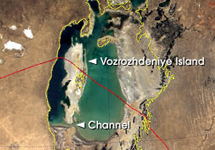Jonathan Tucker
Raymond Zilinskas
Sonia Ben Ouagrham
March 19, 2002

Vozrozhdeniya Island,
Source: WikiMedia Commons
A Joint Working Group
On February 27, 2002, the Russian government announced that experts from the Russian Ministry of Civil Defense, Emergencies and Natural Disasters will conduct joint research with scientists from Kazakhstan to assess the contamination of Vozrozhdeniye Island (“Rebirth Island” in English), a Soviet-era biological weapons test site in the Aral Sea. According to Gennadiy Korotkin, Russian deputy minister for emergency situations, Russia and Kazakhstan have created a joint working group to organize research activities on the island. (1) This working group will decide what research is needed to assess the contamination of the island, the methodologies to be used, and project financing. Russia and Kazakhstan will sign a final agreement in May, after which Russia plans to negotiate a similar bilateral agreement with Uzbekistan. (1)
Open-Air Test Site for Biological Weapons
From 1936 to 1991, the Soviet Union used Vozrozhdeniye Island as an open-air test site for biological weapons, including the causative agents of anthrax, plague, tularemia, and smallpox. (2) Although the Aral Sea was once the world’s fourth largest inland body of water, in the 1960s the Soviet Union began to divert its feeder-rivers into concrete irrigation canals as part of an effort to grow cotton. This diversion dramatically lowered the sea level around the island, ultimately creating a land bridge between the island and the Uzbek mainland in late 2001.
In 1992, Kanatjan Alibekov (a.k.a. Ken Alibek), a senior Soviet bioweapons scientist, defected to the United States and revealed that large quantities of anthrax spores, partially decontaminated with bleach, had been buried in pits on Vozrozhdeniye Island in 1988. Experts from the US Department of Defense subsequently located the burial sites and detected viable anthrax spores in the soil. In late 2001, the formation of a land bridge to the island, coupled with the events of September 11 and the subsequent anthrax attacks in the United States, raised serious concerns about the accessibility of the island to terrorists intent on acquiring deadly biological pathogens. On October 22, 2001, the United States signed an agreement with Uzbekistan pledging $6 million to decontaminate the anthrax burial sites and to dismantle a former biological weapons laboratory on the island. (3) The US government plans to complete the decontamination phase of the project by the end of 2002; dismantlement of the laboratory could take an additional two years.
Plans for Research on Vozrozhdeniye Island
The announcement of Russia’s plan to participate in research on the contamination of Vozrozhdeniye Island caught the United States by surprise. It is unclear if Russia will seek to join the existing effort supported by the US government or will develop its own projects. Given the Russian government’s extensive knowledge of Soviet-era BW activities on the island, it could provide valuable assistance in assessing current contamination problems. One worrisome possibility, for example, is that rodents living on the island could have become infected with a weaponized strain of plague bacteria. Plague is known to persist in rodent populations and may be carried by fleas to infect humans.
Notes
(1) BBC Monitoring Service/Interfax, “Russia to Join Research on Former Soviet Bioweapons Test Range in Aral Sea,” Financial Times, February 27, 2002, http://globalarchive.ft.com.
(2) Jonathan B. Tucker, Ambassador Shavkat Khamrakulov, and Alla Karimova, “Biological Decontamination of Vozrozhdeniye Island: The US–Uzbek Agreement,” Center for Nonproliferation Studies, www.nonproliferation.org.
(3) Philipp C. Bleek, “US to Clean Up Soviet-Era Germ Warfare Site in Uzbekistan,” Arms Control Today, November 2001, www.armscontrol.org.
